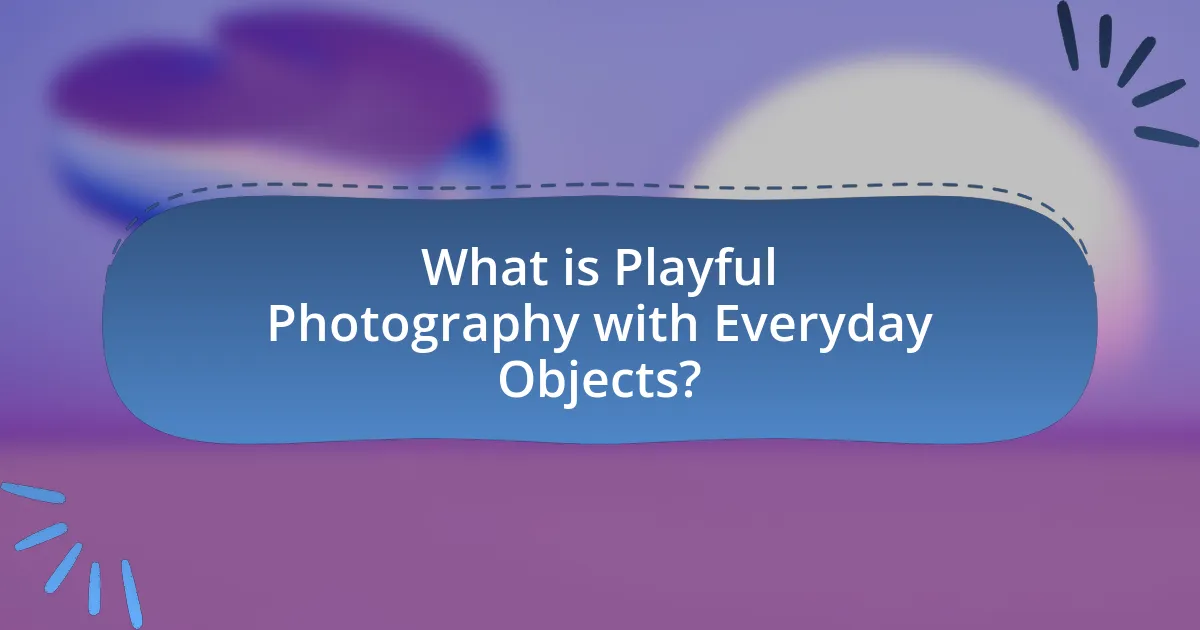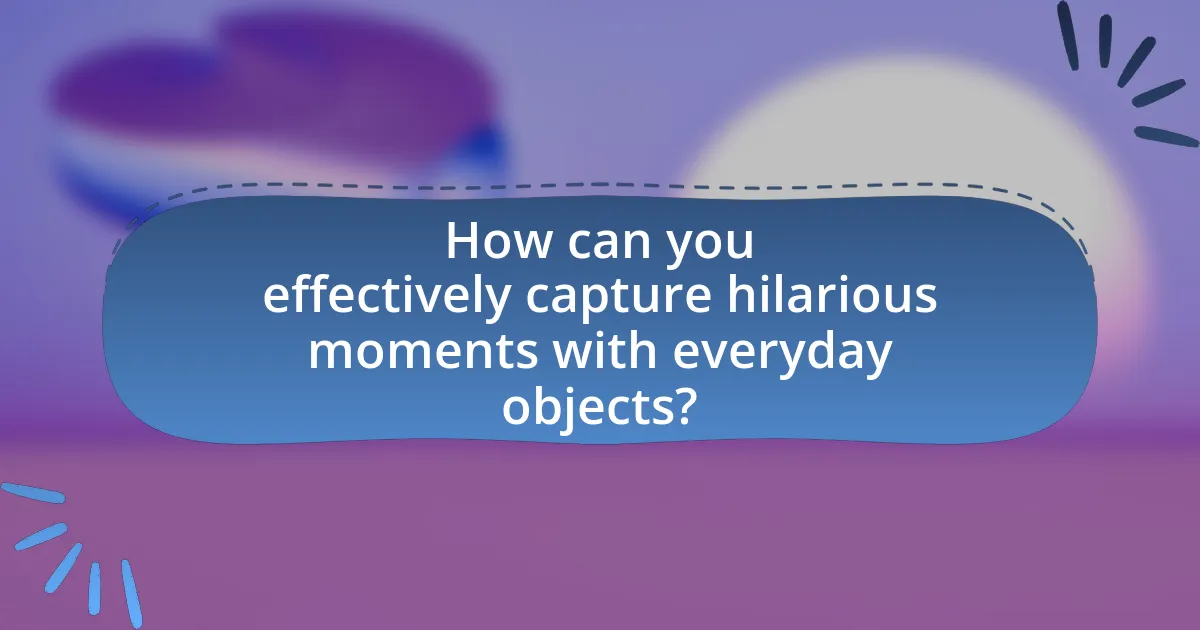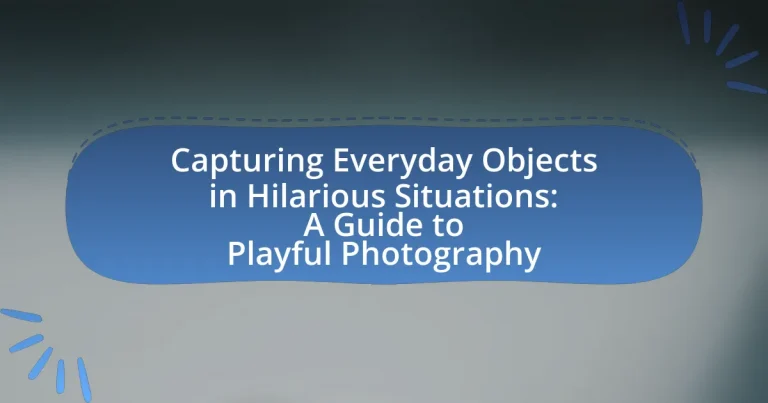The article focuses on playful photography with everyday objects, emphasizing how common items can be transformed into humorous subjects through creative compositions and perspectives. It explores techniques for enhancing comedic effects, such as exaggerated perspectives, unexpected juxtapositions, and clever timing, while discussing the psychological benefits of humor in photography. Key elements of this art form include creativity, spontaneity, and effective composition, which together foster viewer engagement and emotional responses. The article also provides practical tips for capturing hilarious moments, staging funny scenarios, and developing a comedic photography style, along with resources for inspiration.

What is Playful Photography with Everyday Objects?
Playful photography with everyday objects is a creative approach that involves using common items to create humorous or whimsical images. This style encourages photographers to see the potential for storytelling and fun in mundane objects, transforming them into subjects of interest through imaginative compositions and perspectives. For instance, a simple fruit can be staged to appear as a character in a narrative, showcasing the versatility of everyday items in artistic expression. This method not only enhances creativity but also makes photography accessible, as it requires minimal resources while fostering a playful mindset.
How can everyday objects be transformed into humorous subjects?
Everyday objects can be transformed into humorous subjects by creatively altering their context or presenting them in unexpected scenarios. For instance, placing a common item like a banana in a situation where it appears to be engaged in a human activity, such as reading a book or driving a toy car, creates a comedic effect. This technique leverages the element of surprise and absurdity, which are key components of humor. Research in psychology indicates that humor often arises from incongruity, where the unexpected juxtaposition of familiar objects leads to laughter. Therefore, by recontextualizing everyday items in playful and absurd ways, photographers can effectively evoke humor.
What techniques can enhance the comedic effect in photography?
Techniques that can enhance the comedic effect in photography include the use of exaggerated perspectives, unexpected juxtapositions, and clever timing. Exaggerated perspectives, such as forced perspective, can create humorous illusions by manipulating the size and distance of objects, making them appear larger or smaller than they are. Unexpected juxtapositions, where unrelated elements are placed together in a single frame, can generate surprise and laughter, as seen in the work of photographers like Martin Parr, who often captures absurdities in everyday life. Clever timing, particularly in candid photography, allows for the capture of spontaneous moments that reveal humor, such as a pet making a funny face or a person caught mid-laugh. These techniques are effective because they play with viewer expectations and create visual puns, leading to a more engaging and amusing photographic experience.
How does perspective influence the humor in everyday object photography?
Perspective significantly influences the humor in everyday object photography by altering the viewer’s perception and context of the subject. When photographers manipulate angles, distances, and focal points, they can create unexpected juxtapositions or exaggerate features, leading to comedic effects. For instance, shooting a small object from a low angle can make it appear monumental, while a close-up of a mundane item can highlight absurd details, prompting laughter. This technique is supported by the principles of visual humor, which suggest that incongruity and surprise are key elements in eliciting amusement.
Why is capturing humor in photography important?
Capturing humor in photography is important because it engages viewers and evokes emotional responses, making images more memorable. Humor can break the ice and create connections between the subject and the audience, enhancing the overall impact of the photograph. Studies show that humorous content is more likely to be shared and remembered, as it stimulates positive emotions and encourages social interaction. For instance, a survey by the American Psychological Association found that humor in visual media increases viewer retention by up to 60%, demonstrating its effectiveness in communication and storytelling.
What psychological effects does humor have on viewers?
Humor has several psychological effects on viewers, primarily enhancing mood and reducing stress. When individuals engage with humorous content, their brains release endorphins, which are chemicals that promote feelings of happiness and well-being. Research indicates that laughter can lower levels of cortisol, a stress hormone, thereby alleviating anxiety and promoting relaxation. Additionally, humor fosters social connections, as shared laughter can strengthen interpersonal bonds and improve group dynamics. Studies have shown that humor can also enhance cognitive flexibility, allowing individuals to approach problems with a more open and creative mindset.
How can humor in photography foster creativity?
Humor in photography fosters creativity by encouraging photographers to think outside conventional norms and explore unique perspectives. When humor is integrated into photography, it prompts the artist to experiment with composition, lighting, and subject matter in unexpected ways, leading to innovative visual storytelling. Studies have shown that humor stimulates the brain’s reward system, enhancing cognitive flexibility and problem-solving skills, which are essential for creative expression. This playful approach allows photographers to break free from traditional constraints, resulting in more imaginative and engaging images.

What are the key elements of playful photography?
The key elements of playful photography include creativity, humor, perspective, and spontaneity. Creativity allows photographers to envision unique scenarios, while humor adds an entertaining aspect that engages viewers. Perspective is crucial as it influences how subjects are framed, often leading to unexpected and amusing compositions. Spontaneity captures candid moments that enhance the playful nature of the images. These elements work together to transform ordinary scenes into delightful visual narratives, making playful photography an engaging art form.
How does composition affect the humor in photographs?
Composition significantly affects the humor in photographs by influencing how elements are arranged and perceived within the frame. Effective composition can create visual puns, enhance absurdity, or juxtapose unexpected elements, thereby amplifying comedic impact. For instance, placing a small object next to a much larger one can create a humorous contrast, as seen in the famous “big and small” photography style, which often elicits laughter through exaggeration. Additionally, the rule of thirds can guide the viewer’s eye to the focal point of humor, ensuring that the punchline of the image is immediately recognizable. Studies in visual perception indicate that well-composed images are more likely to engage viewers, making the humor more effective.
What compositional techniques can be used to create funny images?
Compositional techniques that can be used to create funny images include exaggeration, juxtaposition, and perspective manipulation. Exaggeration involves amplifying certain features or actions of subjects to enhance humor, such as depicting a small object in a large context to create absurdity. Juxtaposition places contrasting elements together, like a serious expression on a playful object, to generate unexpected humor. Perspective manipulation, such as using forced perspective, can create visual puns or illusions that surprise the viewer, making the image more amusing. These techniques are effective because they play with viewer expectations and create a sense of surprise, which is a key element of humor in visual storytelling.
How does lighting play a role in enhancing humor?
Lighting significantly enhances humor by influencing the mood and perception of a scene. Proper lighting can create dramatic contrasts, highlight facial expressions, and emphasize comedic elements, making them more visually engaging. For instance, soft lighting can evoke a warm, inviting atmosphere, while harsh lighting can create exaggerated shadows that amplify comedic effects. Research indicates that well-lit environments can improve audience engagement and emotional responses, thereby enhancing the overall humor of a photograph or performance.
What props and settings work best for playful photography?
Bright colors, whimsical props, and dynamic settings work best for playful photography. Utilizing items like oversized sunglasses, colorful balloons, or playful costumes can enhance the fun aspect of the images. Settings such as parks, playgrounds, or vibrant urban environments provide a lively backdrop that complements the playful theme. Research indicates that environments with high visual stimulation, such as those featuring contrasting colors and interesting textures, can significantly increase viewer engagement and enjoyment in photographs.
Which everyday objects lend themselves to humorous situations?
Everyday objects that lend themselves to humorous situations include bananas, socks, and rubber chickens. Bananas are often used in comedic contexts due to their shape and the classic slipping gag, which has been a staple in physical comedy for decades. Socks can create humor through mismatched pairs or when they are humorously depicted as characters, often seen in cartoons and children’s media. Rubber chickens are iconic in slapstick comedy, serving as a prop that evokes laughter due to their absurdity and exaggerated features. These objects are frequently utilized in playful photography to capture lighthearted moments, reinforcing their role in humor.
How can different environments influence the comedic narrative?
Different environments significantly influence the comedic narrative by shaping the context and interactions of characters and objects. For instance, a mundane setting like a kitchen can become humorous when everyday items, such as a toaster or a spatula, are anthropomorphized or placed in absurd situations, creating a contrast between the ordinary and the unexpected. Research in humor theory, such as the Incongruity Theory, suggests that humor arises when there is a discrepancy between what is expected and what actually occurs, which is often heightened by the environment. Therefore, the choice of setting can enhance comedic elements by providing a backdrop that amplifies the absurdity of the narrative.

How can you effectively capture hilarious moments with everyday objects?
To effectively capture hilarious moments with everyday objects, utilize creative angles and unexpected contexts to highlight humor. For instance, photographing a common item like a banana in a silly position or juxtaposing it with an unrelated object can create a comedic effect. Research shows that humor in photography often arises from incongruity, where the unexpected pairing of objects elicits laughter. A study published in the Journal of Experimental Psychology found that humor is often derived from surprise and the violation of expectations, supporting the idea that playful arrangements of everyday items can lead to amusing images.
What are some tips for staging funny scenarios?
To stage funny scenarios effectively, utilize everyday objects in unexpected ways to create humor. For instance, placing a common item, like a banana, in a context where it doesn’t belong, such as a business meeting, can evoke laughter. Additionally, consider using exaggerated expressions or poses with the objects to enhance the comedic effect. Research shows that incongruity, where the outcome is surprising or absurd, is a key element in humor (Morreall, 1983). By combining these techniques, you can create engaging and amusing photographs that capture the essence of playful scenarios.
How can you use storytelling to enhance the humor in your photos?
You can use storytelling to enhance the humor in your photos by creating a narrative that gives context to the scene, making the viewer more engaged and amused. For instance, incorporating elements like exaggerated expressions, unexpected scenarios, or anthropomorphism can transform an ordinary object into a character with a funny story. This technique is supported by the principle that humor often arises from incongruity, where the unexpected twist in the narrative leads to laughter. By framing your photos with a clear storyline, you invite viewers to interpret the humor, thus increasing the overall impact of the image.
What role does timing play in capturing the perfect shot?
Timing is crucial in capturing the perfect shot as it determines the moment when the subject is most expressive or dynamic. In playful photography, such as capturing everyday objects in humorous situations, the right timing can highlight unexpected interactions or reactions, making the image more engaging. For instance, a well-timed photograph of a dog catching a frisbee mid-air can evoke joy and excitement, while a delayed shot may miss the peak of that action, resulting in a less impactful image. Studies in photography emphasize that timing can significantly influence the emotional response of viewers, reinforcing the importance of capturing moments at their peak.
What common mistakes should be avoided in playful photography?
Common mistakes to avoid in playful photography include poor composition, lack of focus on the subject, and insufficient lighting. Poor composition can lead to cluttered images that distract from the playful elements, while a lack of focus on the subject can result in missed opportunities to highlight humor. Insufficient lighting can diminish the vibrancy and clarity of the photograph, making it less engaging. According to photography experts, well-composed images with clear subjects and adequate lighting significantly enhance the viewer’s experience and the effectiveness of playful photography.
How can overthinking a scene detract from its humor?
Overthinking a scene can detract from its humor by introducing unnecessary complexity that obscures the comedic elements. When creators analyze every detail excessively, they may lose the spontaneity and naturalness that often contribute to humor. For instance, humor frequently relies on timing and surprise; overthinking can lead to over-planned setups that feel forced or contrived, diminishing the audience’s enjoyment. Research in psychology indicates that humor is often linked to incongruity and unexpectedness, which can be undermined when a scene is overly dissected or meticulously crafted.
What are the pitfalls of relying too heavily on props?
Relying too heavily on props can lead to a lack of authenticity in photography. When photographers depend excessively on props, the focus may shift from the subject to the objects, resulting in images that feel staged rather than spontaneous. This can diminish the emotional connection viewers have with the photograph, as genuine moments often resonate more than artificially constructed scenes. Additionally, overuse of props can clutter the composition, making it difficult for the main subject to stand out, which is crucial in playful photography that aims to highlight everyday objects in humorous contexts.
What practical tips can enhance your playful photography skills?
To enhance your playful photography skills, experiment with different angles and perspectives to create unexpected compositions. This approach allows you to capture everyday objects in humorous and engaging ways, transforming the mundane into the extraordinary. For instance, shooting from a low angle can exaggerate the size of an object, making it appear more significant and comical. Additionally, incorporating props or costumes can add a layer of whimsy to your images, encouraging creativity and spontaneity. Engaging with your environment and using natural light effectively can also elevate the playful quality of your photographs, as bright, well-lit scenes tend to evoke a sense of joy and fun.
How can you practice and develop your comedic photography style?
To practice and develop your comedic photography style, consistently experiment with everyday objects in humorous contexts. This involves setting up scenarios that exaggerate the characteristics of the objects, using props, and incorporating unexpected elements to create visual punchlines. Research indicates that humor in photography often relies on surprise and relatability, which can be enhanced by studying comedic timing and composition techniques. Engaging with communities focused on comedic photography can provide feedback and inspiration, further refining your style.
What resources are available for inspiration in playful photography?
Resources available for inspiration in playful photography include online platforms, photography books, and social media communities. Websites like Pinterest and Instagram showcase a plethora of playful photography examples, allowing photographers to explore creative ideas and techniques. Additionally, books such as “The Art of Playful Photography” by David duChemin provide insights and practical tips for capturing humor in everyday objects. Social media groups and forums dedicated to photography often share challenges and themes that encourage playful experimentation, fostering a community of like-minded individuals. These resources collectively enhance creativity and provide a foundation for playful photographic expression.


